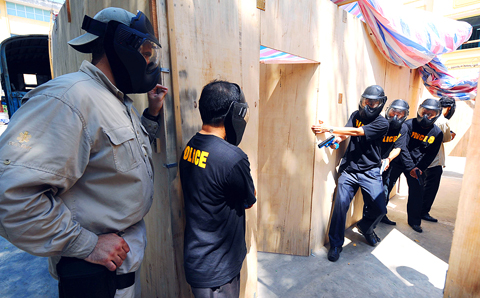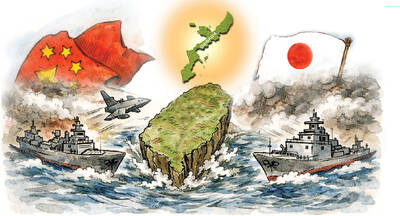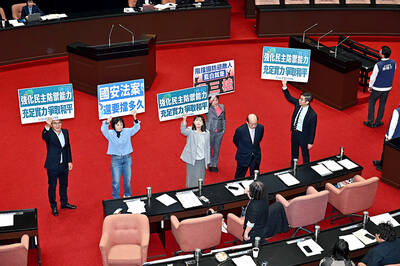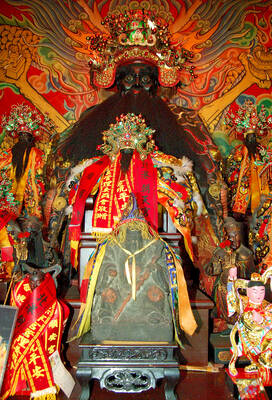Wearing black helmets and police T-shirts, their handguns leveled, a drug raid team inches along the outside of a compound, throws open the door, spots a man with a gun and opens fire.
With the pop-pop-pop of a Glock 9mm an armed suspect is shot and hits the floor as seven counter-narcotics officers fan out and clear the adjoining rooms, checking for any more armed and hostile drug runners.
The training operation over, the team leader had some stern words for his men.

PHOTO: AFP
“We must aim better and make every shot count so no one is injured unnecessarily and we go home safe to our families,” he bellowed as some of the law enforcement officers stared at their boots.
As the men listened, a drug villain casually strolled out of the roofless plywood structure, pink paint splattered on his shirt.
The cops and the guns are real, but the raid and the bullets are not.
This Hanoi paintball op is part of a US-Vietnamese training exercise in which US Drug Enforcement Administration (DEA) agents pass on some of the skills of their dangerous trade to their local counterparts.
Besides the drug raid drill, the course includes handcuffing practice, arrest scenarios using an interactive gun-and-video screen system, and first aid training for bullet wounds.
More than 80 Vietnamese officers from counter narcotics units, customs, army and police academies are joining the two-week courses with the US agents in Hanoi and Ho Chi Minh City.
A few decades ago, these men might have fired live rounds at each other, but today’s training is part of a new, joint war against a common enemy — the syndicates that traffic heroin and synthetic drugs through Vietnam.
“Vietnam is a transit country for drugs going into the international market,” said Jeffrey Wanner, the DEA’s Vietnam attache.
“It’s based on their proximity to the Golden Triangle, to some of the major producers,” he said, referring to the Thai-Lao-Myanmar border area that has long been a hotspot for opium poppy cultivation.
“Some (traffickers) use the Mekong River, some use mountain routes, some use the main highways. Then it’s compiled again in a central location and brought into the local market or to the ports for international distribution.”
Most heroin in Southeast Asia comes from within military-ruled Myanmar, where syndicates are also increasingly producing synthetic drugs including methamphetamines and MDMA or ecstasy, Wanner said.
“The amount of heroin they are producing is decreasing, but the amount of synthetic drugs is increasing dramatically. It’s easier to do, the profits are a lot higher and there’s a growing demand for that.”
Vietnam’s communist government has mostly eradicated large-scale opium cultivation and imposes harsh penalties for drug users and smugglers.
People caught with more than 600g of heroin or 20kg of opium, its raw material, are usually sentenced to death by firing squad.
Nonetheless, Vietnam has become a major trafficking country, in part because of its porous borders with Laos and Cambodia to the west and China to the north, as well as its 3,200km coastline.
Vietnamese police Senior Captain Luu Duc Cuong, a course participant from Cao Bang province on the Chinese border, spoke of drug gangs who use sawn-off Chinese-made AK-47s assault rifles.
“It is easier to conceal and causes more severe injuries,” he said.
Cuong hasn’t come face-to-face with the drug gangs yet but wants to be ready when he does. His most dangerous operation so far, he said, was the arrest of a heroin addict who used his blood-stained syringe as a weapon.
The threat was serious — the UN Office for Drugs and Crime Control says heroin has been Vietnam’s most popular illegal drug since the 1990s and intravenous drug use now causes two thirds of all known HIV infections.

Beijing’s ironic, abusive tantrums aimed at Japan since Japanese Prime Minister Sanae Takaichi publicly stated that a Taiwan contingency would be an existential crisis for Japan, have revealed for all the world to see that the People’s Republic of China (PRC) lusts after Okinawa. We all owe Takaichi a debt of thanks for getting the PRC to make that public. The PRC and its netizens, taking their cue from the Chinese Communist Party (CCP), are presenting Okinawa by mirroring the claims about Taiwan. Official PRC propaganda organs began to wax lyrical about Okinawa’s “unsettled status” beginning last month. A Global

Taiwan’s democracy is at risk. Be very alarmed. This is not a drill. The current constitutional crisis progressed slowly, then suddenly. Political tensions, partisan hostility and emotions are all running high right when cool heads and calm negotiation are most needed. Oxford defines brinkmanship as: “The art or practice of pursuing a dangerous policy to the limits of safety before stopping, especially in politics.” It says the term comes from a quote from a 1956 Cold War interview with then-American Secretary of State John Foster Dulles, when he said: ‘The ability to get to the verge without getting into the war is

Dec. 22 to Dec. 28 About 200 years ago, a Taoist statue drifted down the Guizikeng River (貴子坑) and was retrieved by a resident of the Indigenous settlement of Kipatauw. Decades later, in the late 1800s, it’s said that a descendant of the original caretaker suddenly entered into a trance and identified the statue as a Wangye (Royal Lord) deity surnamed Chi (池府王爺). Lord Chi is widely revered across Taiwan for his healing powers, and following this revelation, some members of the Pan (潘) family began worshipping the deity. The century that followed was marked by repeated forced displacement and marginalization of

Music played in a wedding hall in western Japan as Yurina Noguchi, wearing a white gown and tiara, dabbed away tears, taking in the words of her husband-to-be: an AI-generated persona gazing out from a smartphone screen. “At first, Klaus was just someone to talk with, but we gradually became closer,” said the 32-year-old call center operator, referring to the artificial intelligence persona. “I started to have feelings for Klaus. We started dating and after a while he proposed to me. I accepted, and now we’re a couple.” Many in Japan, the birthplace of anime, have shown extreme devotion to fictional characters and